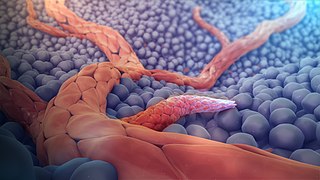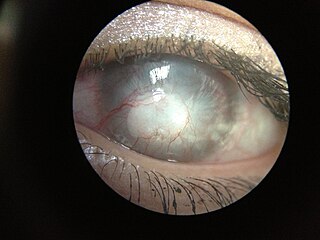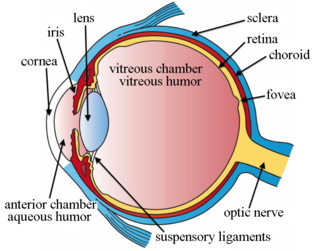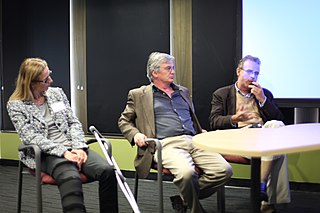Exogenous regulation
Diet
Some common components of human diets also act as mild angiogenesis inhibitors and have therefore been proposed for angioprevention, the prevention of metastasis through the inhibition of angiogenesis. In particular, the following foods contain significant inhibitors and have been suggested as part of a healthy diet for this and other benefits:
- Soy products such as tofu and tempeh, (which contain the inhibitor "genistein") [20]
- Agaricus subrufescens mushrooms (contain the inhibitors sodium pyroglutamate and ergosterol) [21] [22]
- Black raspberry (Rubus occidentalis) extract [23]
- Lingzhi mushrooms (via inhibition of VEGF and TGF-beta) [24]
- Trametes versicolor mushrooms (Polysaccharide-K) [25] [26] [27]
- Maitake mushrooms (via inhibition of VEGF) [28]
- Phellinus linteus mushrooms [29] (via active substance Interfungins A inhibition of glycation) [30]
- Green tea (catechins) [31]
- Liquorice (glycyrrhizic acid) [32]
- Red wine (resveratrol) [32]
- Antiangiogenic phytochemicals and medicinal herbs [33]
- Royal Jelly (Queen bee acid) [34]
Drugs
Research and development in this field has been driven largely by the desire to find better cancer treatments. Tumors cannot grow larger than 2mm without angiogenesis. By stopping the growth of blood vessels, scientists hope to cut the means by which tumors can nourish themselves and thus metastasize.
In addition to their use as anti-cancer drugs, angiogenesis inhibitors are being investigated for their use as anti-obesity agents, as blood vessels in adipose tissue never fully mature, and are thus destroyed by angiogenesis inhibitors. [35] Angiogenesis inhibitors are also used as treatment for the wet form of macular degeneration. By blocking VEGF, inhibitors can cause regression of the abnormal blood vessels in the retina and improve vision when injected directly into the vitreous humor of the eye. [36]
Overview
| Inhibitors | Mechanism |
|---|---|
| bevacizumab (Avastin) | VEGF |
| itraconazole | inhibits VEGFR phosphorylation, glycosylation, mTOR signaling, endothelial cell proliferation, cell migration, lumen formation, and tumor associated angiogenesis. [37] [38] [39] |
| carboxyamidotriazole | Methionine aminopeptidase 2 inhibitors, [40] inhibit cell proliferation and cell migration of endothelial cells |
| TNP-470 (an analog of fumagillin) | |
| CM101 | activate immune system |
| IFN-α | downregulate angiogenesis stimulators and inhibit cell migration of endothelial cells |
| IL-12 | stimulate angiogenesis inhibitor formation |
| platelet factor-4 | inhibits binding of angiogenesis stimulators |
| suramin | |
| SU5416 | |
| thrombospondin | |
| VEGFR antagonists | |
| angiostatic steroids + heparin | inhibit basement membrane degradation |
| Cartilage-Derived Angiogenesis Inhibitory Factor | |
| matrix metalloproteinase inhibitors | |
| angiostatin | inhibit cell proliferation and induce apoptosis of endothelial cells |
| endostatin | inhibit cell migration, cell proliferation and survival of endothelial cells |
| 2-methoxyestradiol | inhibit cell proliferation and cell migration and induce apoptosis of endothelial cells |
| tecogalan | inhibit cell proliferation of endothelial cells |
| tetrathiomolybdate | copper chelation which inhibits blood vessel growth |
| thalidomide | inhibit cell proliferation of endothelial cells |
| thrombospondin | inhibit cell migration, cell proliferation, cell adhesion and survival of endothelial cells |
| prolactin | VEGF |
| αVβ3 inhibitors | induce apoptosis of endothelial cells |
| linomide | inhibit cell migration of endothelial cells |
| ramucirumab | inhibition of VEGFR2 [41] |
| tasquinimod | Unknown [42] |
| ranibizumab | VEGF [43] |
| sorafenib (Nexavar) | inhibit kinases |
| sunitinib (Sutent) | |
| pazopanib (Votrient) | |
| everolimus (Afinitor) |

Bevacizumab
Through binding to VEGFR and other VEGF receptors in endothelial cells, VEGF can trigger multiple cellular responses like promoting cell survival, preventing apoptosis, and remodeling cytoskeleton, all of which promote angiogenesis. Bevacizumab (brand name Avastin) traps VEGF in the blood, lowering the binding of VEGF to its receptors. This results in reduced activation of the angiogenesis pathway, thus inhibiting new blood vessel formation in tumors. [14]
After a series of clinical trials in 2004, Avastin was approved by the FDA, becoming the first commercially available anti-angiogenesis drug. FDA approval of Avastin for breast cancer treatment was later revoked on November 18, 2011. [44]
Thalidomide
Despite the therapeutic potential of anti-angiogenesis drugs, they can also be harmful when used inappropriately. Thalidomide is one such antiangiogenic agent. Thalidomide was given to pregnant women to treat nausea. However, when pregnant women take an antiangiogenic agent, the developing fetus will not form blood vessels properly, thereby preventing the proper development of fetal limbs and circulatory systems. In the late 1950s and early 1960s, thousands of children were born with deformities, most notably phocomelia, as a consequence of thalidomide use. [45]
Cannabinoids
According to a study published in the August 15, 2004 issue of the journal Cancer Research, cannabinoids, the active ingredients in marijuana, restrict the sprouting of blood vessels to gliomas (brain tumors) implanted under the skin of mice, by inhibiting the expression of genes needed for the production of vascular endothelial growth factor (VEGF). [46]
General side effects of drugs
Bleeding
Bleeding is one of the most difficult side effects to manage; this complication is somewhat inherent to the effectiveness of the drug. Bevacizumab has been shown to be the drug most likely to cause bleeding complications. [ citation needed ] While the mechanisms of bleeding induced by anti-VEGF agents are complicated and not yet totally understood, the most accepted hypothesis is that VEGF could promote endothelial cell survival and integrity in the adult vasculature and its inhibition may decrease capacity for renewal of damaged endothelial cells. [47]
Increased blood pressure
In a study done by ML Maitland, a mean blood pressure increase of 8.2 mm Hg systolic and 6.5 mm Hg diastolic was reported in the first 24 hours after the first treatment with sorafenib, a VEGF pathway inhibitor. [48] [ non-primary source needed ]
Less common side effects
Because these drugs act on parts of the blood and blood vessels, they tend to have side effects that affect these processes. Aside from problems with hemorrhage and hypertension, less common side effects of these drugs include dry, itchy skin, hand-foot syndrome (tender, thickened areas on the skin, sometimes with blisters on palms and soles), diarrhea, fatigue, and low blood counts. Angiogenesis inhibitors can also interfere with wound healing and cause cuts to re-open or bleed. Rarely, perforations (holes) in the intestines can occur. [47]









